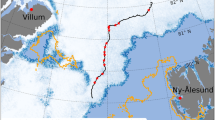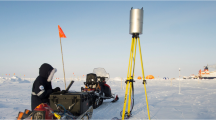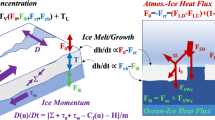Abstract
REMOTE sensing using an airborne infrared lidar1 has shown an unexpected capability to detect open leads (linear openings) in Arctic sea ice and their associated meteorology in winter. Here we show that vertical profiles of backscattered radiation demonstrate strong returns from hydrometeor plumes originating from leads having a surface water temperature near –1.8 °C. Recently refrozen leads are also distinguishable by the lidar backscatter from adjacent thicker, older sea ice. Wide leads release enough energy to create buoyant plumes which penetrate the Arctic boundary layer inversion, transporting heat and moisture into the troposphere. These results show that the role of the Arctic as a global heat sink may need to be re-evaluated, and that lead plumes have a significant effect on the radiation budget.
This is a preview of subscription content, access via your institution
Access options
Subscribe to this journal
Receive 51 print issues and online access
$199.00 per year
only $3.90 per issue
Buy this article
- Purchase on Springer Link
- Instant access to full article PDF
Prices may be subject to local taxes which are calculated during checkout
Similar content being viewed by others
References
Uthe, E. E., Morley, B. M. & Nielsen, N. B. Appl. Opt. 21, 460–463 (1982).
Kent, G. S., Poole, L. R. & McCormick, M. P. J. atmos Sci. 43, 2149–2166 (1986)
Schnell, R. C. Arctic Res. 2, 39–41. 1988.
Hobbs, P. V. & Rango, A. L. J. atmos. Sci. 42, 2523–2549 (1985)
Radke, L. F., Brock, C. A., Lyons, J. H., Hobbs, P. V. & Schnell, R. C. J. atmos. Chem. (in the press)
Andreas, E. L. Williams, R. M. & Paulson, C. A. Q. J. R. met. Soc. 107, 437–460 (1981)
Mason, B. J. The Physics of Clouds 2nd edn, 171–172 (Clarendon, Oxford. 1971).
Wadhams, P. Phil. Trans. R. Soc. Lond. A302, 45–85 (1981).
Badgley, F. I. Proc. Symp. Arctic Heat Budget and Atmospheric Circulation 267–277 (Rand Corporation, Santa Monica, 1966).
Andreas, E. L. Mon. Weath. Rev. 108, 2057–2063 (1980)
Maykut, G. A. J. geophys. Res. 87, 7971–7984 (1982)
Makshtas, A. P. The Heat Budget of Arctic ice in the Winter, (ed. Andreas. E. L. ) (National Science Foundation, Division of Polar Programs. Washington, DC, in the press).
Ledley, T. S. J. geophys. Res. 93, 15919–15932 (1988)
Andreas, E. L., Paulson, C. A., Williams, R. M. Lindsay, R. W. & Businger, J. A. Bound. Layer Met. 17, 57–91 (1979).
Smith, S. D., Anderson, R. J., den hartog, G., Topham, D. R. & Perkin, R. G. J. geophys. Res. 88, 2900–2910(1983).
Andreas, E. L. CRREL Rep 82-12 (US Army Cold Regions Research and Engineering Laboratory, Hanover, 1982).
Andreas, E. L. & Murphy, B. J. phys. Oceanogr. 16, 1875–1883 (1986)
Curry, J. A., Radke, L. F., Brock, C. A. & Ebert, E. E., Symp. Role of Clouds in Air Chemistry and Global Climate 114–117 (American Meteorological Society, Boston, 1989).
Barry, R. G., Miles, M. W., Cianflone, R. C., Scharfen, G. & Schnell, R. C. Ann. Glaciol. 12, 9–15 (1989).
Author information
Authors and Affiliations
Rights and permissions
About this article
Cite this article
Schnell, R., Barry, R., Miles, M. et al. Lidar detection of leads in Arctic sea ice. Nature 339, 530–532 (1989). https://doi.org/10.1038/339530a0
Received:
Accepted:
Issue Date:
DOI: https://doi.org/10.1038/339530a0
This article is cited by
-
Midwinter Arctic leads form and dissipate low clouds
Nature Communications (2020)
-
‘Observations and Modelling of Cold-air Advection over Arctic Sea Ice’
Boundary-Layer Meteorology (2005)
-
Evidence for bromine monoxide in the free troposphere during the Arctic polar sunrise
Nature (1999)
-
Turbulent transport from an arctic lead: A large-eddy simulation
Boundary-Layer Meteorology (1992)
Comments
By submitting a comment you agree to abide by our Terms and Community Guidelines. If you find something abusive or that does not comply with our terms or guidelines please flag it as inappropriate.



